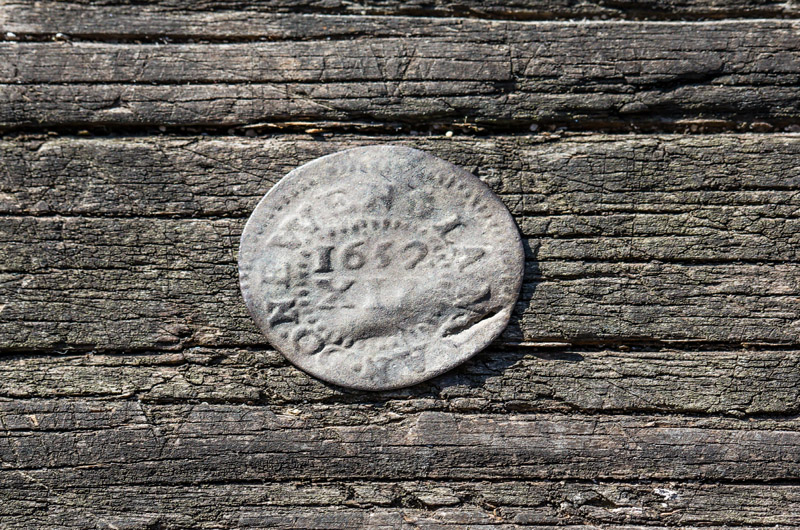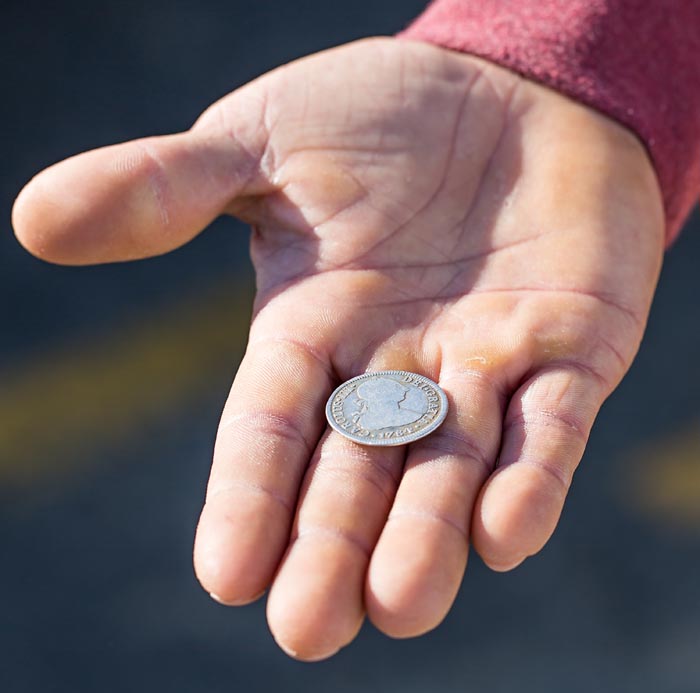It is the oldest coin known to have been found on Martha’s Vineyard — so old that Thomas Mayhew, the proprietor who settled the Island in 1642, might have held it in his hand.
The coin is a 1652 pine tree shilling, among the first to be minted in colonial Massachusetts. Tim Sauer of Edgartown found it on a town beach (he won’t say more than that) while metal detecting in December.
“I was finding a bunch of clad change, just regular modern change, which were all really, really thin and just worn away because of the salt,” Mr. Sauer said. “And when I found this one, it didn’t really dawn on me that it was a different color. A lot of the copper coins become very bright orange and deteriorated. The dimes, sometimes they get green. But this thing was black and I didn’t see anything on it and I just put it in my pocket.”
The next day he went through his finds and noticed that one of the coins was different.
“I’m going through each one, rubbing the sand off it and putting it into my change dish to buy candy bars later. And I come across that one, and it had dried out a little bit and the date started popping,” he said.
The coin was as big around as a washer, light as a Wheat Thin and — as befits a coin that may have been buried in the sand for more than 350 years — bent into a wavelike pattern. A crease and a tiny hole marred one edge. One side showed the faint outline of a pine tree surrounded by the name of the colony: IN MASATHVSETS. The other side, hand struck slightly off-center, showed the date above the Roman number XII (for twelve pence) and the words NEW ENGLAND and AN. DOM.
Mr. Sauer is 29, an Island native and carpenter. He’s been metal detecting for a couple of years, and when he realized what he’d dug up from the shoreline, he texted his friends. First were Wolfie Blair and Luke Brewer, both veteran metal detectors. Both men had found extraordinary coins on the Island, including Spanish reals dating back to the late 18th century, but none had found a colonial tree coin.
“It’s been on their bucket lists for a long time. They’re a renowned coin,” Mr. Sauer said.
Mr. Blair told him that a pine tree shilling, in excellent condition, had auctioned a few years back for $285,000. With that, Mr. Sauer hit the web.
Online he learned that the pine tree shilling was the third in a series of pre-Revolutionary coins that, despite the date, might have been struck in Boston as late as the 1670s. England didn’t want the colonies minting their own money, and hiding the true date might have kept the mother country in the dark about what was going on. A pine tree shilling was found in a time capsule recently unearthed from beneath the State House in Boston.
Referring to the work of the late Sydney P. Noe, Mr. Sauer learned that his shilling was probably a Noe-17 (“very scarce”), which sounded financially promising. But to get a sharp read on its value, he visited Brian Perry of Cape Cod Gold and Silver in Falmouth early this month.
Mr. Perry suggested that Mr. Sauer have the coin appraised by the Professional Coin Grading Service of Newport Beach, Calif., generally considered to be the best in the numismatic business. A rating from PCGS would eliminate all questions to do with condition and value, he said.
At his computer, Mr. Perry looked up auction prices for pine tree shillings in worn condition. They were going for roughly $400 to $600. “It’s a little damaged, but it’s still collectable. It’s a nice find,” he said.
Mr. Sauer said he’d been offered $2,000 for the shilling, which inspired a discussion over the difference between market value and sentimental value. “If you got the offer for $2,000, I would have sold it in a minute,” Mr. Perry said.
“Maybe,” Mr. Sauer replied. But realizing that the shilling wasn’t worth six figures, he found himself growing even more appreciative of how he found the coin. He now doubted he could part with it. “I don’t know if I’ll ever find one again!” he told Mr. Perry.
“I know what you’re saying,” Mr. Perry said. “It’s going to be hard for you to let it go because you found it, and you get kind of a lift out of it — it’s like hitting the lottery almost. Right now you’ve hit the lottery and you haven’t cashed the ticket in yet.”
In the brief time he’s been metal detecting on the Vineyard, Mr. Sauer has found silver shoe buckles from the colonial era, ax heads, three-ring bullets from Sharp rifles, a silver button from an American bicyclists association that advocated for better roads, an 1867 two-cent piece and a 1687 Irish half penny. It amazed him that our forebears were so careless with their money, especially at a time when it was so hard to come by.
He was satisfied by his visit to the Falmouth store and on the ferry ride home took an expansive view of metal detecting. “It’s a good, healthy hobby, you know?” he said. “That’s what I say about it. It gets you out there in nature. You’re walking around on the beaches, you’re in the woods — it’s cool.”
It pays, he added, even when you don’t cash in what you find.







Comments (15)
Comments
Comment policy »